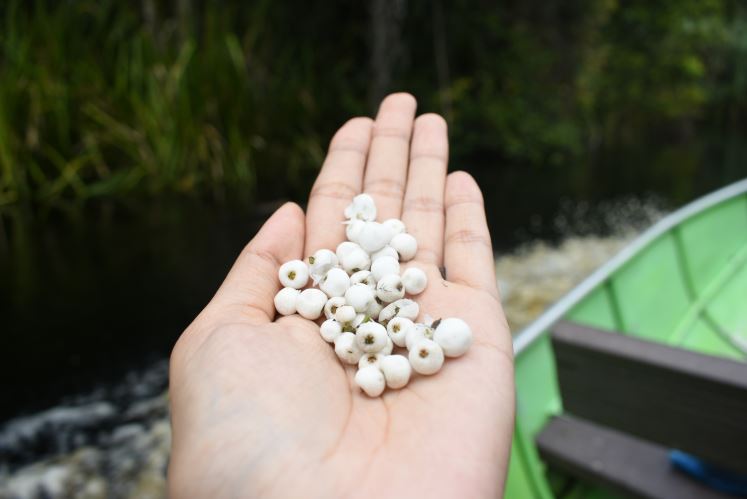March 26, 2025
The Restorasi Ekosistem Riau (RER) project area is home to a wide range of species, each of which plays a critical role in their ecosystem, providing value to people and nature. Syzygium zeylanicum (‘buah nasi-nasi’) offers a range of ecological, medicinal, and economic benefits. However, despite its importance to tropical ecosystems, its survival is threatened due to habitat destruction.
The name ‘buah nasi-nasi’, meaning ‘rice fruit’ in Indonesian, is related to its appearance and texture, which resembles rice. Conservation initiatives are critical to the continued survival of this species in the wild. In this article, we’ll take a closer look at one of Indonesia’s most distinctive flora species to explore its significance, and the efforts being made to protect it.
Taxonomy
Syzygium zeylanicum is a species of flowering bush belonging to the Myrtaceae family. The genus syzygium is renowned for its diversity, with over 1,200 species found in tropical and subtropical regions around the world. Syzygium zeylanicum, in particular, is classified under the following taxonomic hierarchy:
This species is often confused with other syzygium species due to its similar physical characteristics, but its unique fruit and ecological role help distinguish it from its relatives.

Physical Appearance
Syzygium zeylanicum is a small-to-medium-sized plant, with a shrub-like appearance. Its dense foliage provides a broad canopy, making it an important part of the forest ecosystem. The leaves are elliptical, glossy, and leathery, with a distinct aromatic scent when crushed. The flowers are small, white, and fragrant, often growing in clusters and attracting pollinators like bees and butterflies.
Buah nasi-nasi are the fruit of Syzygium zeylanicum. These small, round berries turn from green to snowy white when ripe (hence the name, meaning ‘rice fruits’). The fruit’s pulp is spongy, dry, and sweet, and provides a source of food for various wildlife species.
Habitat
Syzygium zeylanicum grows in tropical rainforests, wetlands, and riparian zones. The species prefers moist, well-drained soils and is often found along riverbanks or in lowland forests throughout Southeast Asia. It can also grow in peat swamp forest with low Ph levels, especially when they are wet for long periods of time. This makes the RER area an ideal habitat for Syzygium zeylanicum.
The plant plays a crucial ecosystem role in its habitat by stabilising soil, preventing erosion, and providing food and shelter for a diverse range of animal species. Due to its ability to take root in degraded areas and thereby support the process of forest recovery, it is also considered a ‘pioneer’ species; as such, it plays an essential role in RER’s ongoing forest regeneration efforts.
Benefits to People and Nature
Syzygium zeylanicum benefits people and nature in various ways. Its dense canopy provides shelter for insects and birds, while its fruits provide a source of food for birds, bats, and small mammals, which, in turn, aid in seed dispersal. This process is essential to the continued health and regeneration of the forest, and also facilitates the rejuvenation of degraded areas.
Various parts of the Syzygium zeylanicum plant can also be utilised by communities in traditional medicine. The bark and leaves contain compounds with antibacterial and antifungal properties, which can be used to treat wounds, infections, and digestive disorders. In addition, the fruit, though astringent, is consumed in some cultures as a natural remedy for diarrhoea and other gastrointestinal ailments.
With its durability and natural resistance to pests, the wood of Syzygium zeylanicum is used in some regions as a building material or in the construction of furniture. The plant is also valued in agroforestry for its ability to enrich soil and support sustainable land management practices.

Conservation Status
Despite its ecological importance, Syzygium zeylanicum faces threats from deforestation, clearing of its riparian habitat for human settlement and agriculture, and climate change. While it is not currently classified as Endangered (EN), populations in certain areas have declined as a result of land use change.
To ensure the survival of this species, and the various benefits it provides to both people and nature, conservation efforts are vitally important. By protecting natural habitats, promoting reforestation, and working with communities to ensure environmental policies are observed and implemented correctly, we can take various steps to safeguard Syzygium zeylanicum and other native flora in Riau and beyond.
RER Efforts in Protecting Biodiversity
RER plays a vital role in preserving biodiversity in Indonesia, including species like Syzygium zeylanicum. The project focuses on restoring and protecting peatland forests, which serve as critical habitats for numerous plant and animal species.
Key efforts by RER include:
For more details on RER conservation initiatives, please visit our website.